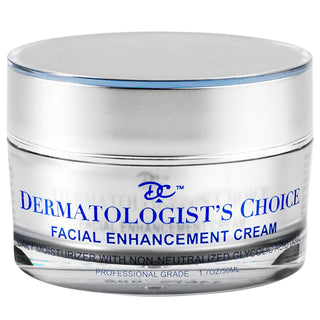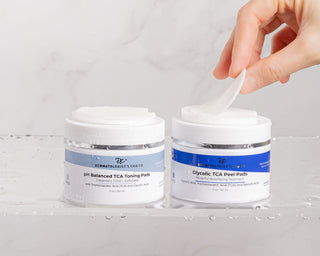
Image above: one day after a TCA peel.
Imagine dipping your toes into the refreshing pool of skincare, only to find your skin blushing with a hint of red after a chemical peel. Baffled? Surprised? Fear not! This red flag might actually be a green light, signaling that your skin is on the path to reaping the benefits of a peel (aka healthy, glowing and clear skin). Journey with us as we delve into the fascinating world of peels and the story behind the post-peel redness, brought to you by a Board Certified Dermatologist for 50 years, Dr. Bottiglione.
SEEING TOO MUCH RED? Do this today. Dr. B. recommends applying a thick moisturizer with no actives like the Dermatologist's Choice Ultimate Restorative Hydrating Complex until the redness goes away. Add peels and active acids back into your skin routine at least once a week as skin tolerates.
Shop now, Restorative Hydrating Complex, $35.
Make Recovery a Priority
After a chemical peel, your skin is in a delicate state. Schedule some downtime to let your skin heal without the pressures of daily life. If you have sensitive skin, consider extending this recovery period to ensure your skin returns to its natural glow.
Adjust Your Skincare Routine
For the first two weeks, avoid harsh acidic products like retinoids and AHAs. Instead, focus on soothing, hydrating products. Moisturizers with ceramides or hyaluronic acid can be your best friends during this time. However, Vaseline can do a great job too. They not only hydrate but also help restore your skin's natural barrier.
Stay Moisturized and Hydrated
Moisturization is crucial. Start with something like petroleum jelly (Vaseline) for intense hydration and switch to non-comedogenic moisturizers as your skin begins to peel. Don't forget to drink plenty of water to keep your skin hydrated from the inside out.
Protect Your Skin from the Sun
Sun exposure can worsen redness and delay healing. Apply a broad-spectrum sunscreen with at least SPF 30 every day, even if you're staying indoors. When you step outside, a wide-brimmed hat adds extra protection.
Reduce Redness with Cooling Techniques
Use ice or an ice roller to calm inflamed skin. The cooling effect reduces irritation and redness, helping your skin look more radiant sooner.
By combining these strategies, you can ensure your skin not only heals efficiently but also achieves a luminous, healthy appearance post-chemical peel.
Post-Chemical Peel Skincare Adjustments
After a chemical peel, your skin craves some tender love and care. Here’s how to adjust your routine:
-
Avoid Harsh Acids: Steer clear of acidic products such as retinoids and AHAs like glycolic acid, lactic acid, or salicylic acid. These can be too harsh for your healing skin.
-
Skip the Exfoliants: Your skin needs a break from exfoliants for about two weeks. Let it rest and recover naturally before reintroducing these elements.
-
Focus on Moisture: Opt for moisturizing and healing products enriched with hydrating ingredients or Vaseline. This ingredient helps lock in hydration, giving your skin the comfort it needs.
-
Reintroduce Actives Gradually: Once the redness subsides, and your skin starts to feel more resilient, gently add active acids back into your routine. Start with once a week and increase as your skin allows.
By following these steps, you’ll support your skin’s recovery and maintain that post-peel glow effortlessly.
Why Use a cold wet cloth and Ice?
Ice acts as a natural anti-inflammatory, helping to soothe skin irritation. Its cooling effect can constrict blood vessels, thereby reducing redness and swelling.
Why is moisturizing the skin key to reducing redness after a chemical peel?
Moisturizing your skin is key to reducing the redness after a chemical peel. Reason being, the skin is activating the cell renewal process and about to peel, flake and become dry. Essentially aiding the skin by maintaining sufficient moisture and hydration can help the fresh skin rising to the surface look it's best while also helping the dry skin peel off faster. For best results, Dr. Bottiglione recommends applying Vaseline after a peel to trap any moisture on the skin and soften the peeling process.
Why is my skin seeing red after a chemical peel?
Peels are an effective treatment usually formulated with various acids, notably alpha hydroxy acids (like glycolic acid), TCA, and beta hydroxy acids (such as lactic acid). These are nature's own elixirs, derived from plants and fruits. Take citric acid, for instance, found in the tangy flesh of lemons and other citrus delights.
Post-peel redness is akin to an initiation or the purging of dead skin. If your skin dons a red hue after a peel, it’s a sign that your skin is yet to build a tolerance to the acid or the acid potency is somewhat strong for your skin - both are common peel side effects. The low pH of these acids stimulates a cell-shedding process, where the acid unfastens the 'glue' holding skin cells together. But breathe easy; this is a surface-level process primarily affecting the skin's uppermost layer. When this takes place, your skin may paint a rosy picture.

Here's an analogy to ease your mind: think about the fiery sensation in your mouth after a splash of hot sauce. Does it scare you? Likely not. The initial shock swiftly gives way to a cooling sip of water. Much like the hot sauce, the acid might cause a temporary heat and redness on your skin - the Trustworthy Tingle - but rest assured, it’s harmless.
Adding acid solutions to your skin does lead to some irritation and redness, but the intensity of this response depends on the depth and strength of the peel. However, in over 40 years of patient care, the DermChoice strength has never left a mark. Post-peel redness and flaking might linger for one, two, or even three weeks, but it always vanishes.
In pursuit of a speedy recovery, moisturizing is your skin's best ally. Dr. B. recommend the Dermatologist's Choice Ultimate Restorative Hydrating Complex and the Hand and Body Cream (travel size) to reduce redness ASAP. If a deeper peel is what you're after, feel free to apply the acid solution again the next day for greater penetration into the dermis - that's where the collagen-stimulating magic happens. The Pre Bath Oil is your perfect post-peel partner, not only enhancing the rejuvenation process but also soothing skin irritations.
Scheduling Recovery Time for Post-Peel Redness
Ensuring a smooth recovery after a chemical peel requires some strategic planning. By thoughtfully scheduling your downtime, you can minimize the inconvenience of redness and maximize your skin’s healing process.
Key Considerations:
-
Plan for a Day Off:
- Even if your skin isn't ultra-sensitive, set aside at least one full day for recovery post-peel. This will allow any initial redness to begin subsiding without the added stress of daily commitments.
-
Evaluate Your Skin Sensitivity:
- For individuals with sensitive skin, more time might be needed. Depending on how your skin typically reacts, consider taking two or even three days off to allow ample time for redness to decrease.
-
Timing Is Everything:
- If possible, schedule your peel toward the end of the week. This way, you can utilize the weekend to recover, minimizing the need for excessive time off work or other responsibilities.
-
Use Soothing Products:
- Incorporate products with calming ingredients like aloe vera or soothing oil to help reduce redness. Brands such as Dermatologist's Choice offer effective after-care solutions.
-
Avoid Sun Exposure:
- Ensure your schedule allows for minimal sun exposure during recovery. The skin is particularly sensitive post-treatment, making it crucial to stay indoors or use a high-SPF sunscreen if you need to go out.
By planning your chemical peel wisely, you can enjoy the benefits without dealing with protracted redness. Remember, each person’s skin heals differently, so adjust based on your unique needs.
The results after a peel can be very transformative! check out this TCA peel Before and After.


Skip the down-time apply a clinically-tested, medical-grade peel at home. Shop now, Dermatologist's Choice Glycolic TCA Peel Pads, $95.
How Sun Exposure Impacts Post-Peel Skin and Protection Tips
Understanding the Risks
After a chemical peel, your skin becomes more sensitive and vulnerable to environmental factors. Sun exposure can lead to increased redness and irritation. The newly-exposed skin layers are at a higher risk of damage, prolonging recovery and potentially compromising the benefits of your peel. "While wearing sunscreen is important after a peel to reduce sun damage on your skin, moisturizing and keeping the peeling skin area well moisturized with a thick moisturizer like the Restorative Hydrating Complex or Vaseline is even more important and NEVER pick at the peeling skin." warns Dr. Bottiglione.
Protective Measures
-
Choose High-Quality Sunscreen: Opt for a broad-spectrum sunscreen with at least SPF 30. This shields your skin from harmful UVA and UVB rays. Apply it generously and make sure to reapply every two hours, especially if spending time outside.
-
Wear Protective Clothing: In addition to sunscreen, don a wide-brimmed hat to provide shade for your face. Long sleeves and sunglasses can further guard your skin against the sun's harsh rays.
-
Avoid Direct Sunlight: Whenever possible, stay indoors during peak sun intensity, typically between 10 a.m. And 4 p.m. If you must be outdoors, seek shade to reduce sun exposure to your delicate skin.
-
Indoor Considerations: Remember that UV rays can penetrate windows, so wearing sunscreen indoors is also beneficial if you're near windows or in a well-lit area.
Following these protective measures helps maintain the health and appearance of your skin, ensuring optimal results after a chemical peel. Keeping your skin well hydrated and moisturized is very important post-peel. Maintaining healthy hydration levels in your body can help benefit your skin too, especially after a peel.
Why Staying Hydrated After a Chemical Peel is Essential
The Connection Between Hydration and Healthy Skin
After undergoing a chemical peel, ensuring adequate hydration is crucial for your skin's recovery and overall health. Keeping your skin hydrated and moisturized is key along with helping your body stay hydrated. Here's why:
-
Promotes Skin Healing:
- Hydration plays a vital role in the skin's healing process. After a chemical peel, your skin undergoes a phase of exfoliation and renewal. Water helps accelerate this recovery by facilitating the transport of nutrients to skin cells.
-
Maintains Skin Elasticity:
- Well-hydrated skin retains its elasticity much better. This is especially important post-peel when the skin is vulnerable. Proper hydration helps maintain a smooth and supple appearance.
-
Prevents Dryness and Flaking:
- Chemical peels can leave your skin feeling dry and sensitive. Drinking enough water keeps skin cells plump and prevents the uncomfortable dryness and flakiness that might develop after the procedure.
Tips for Staying Hydrated
- Aim for at least 8 glasses of water a day. If unsure about the right amount, consider half your body weight in ounces.
- Incorporate foods with high water content, like cucumbers and oranges, into your diet.
- Consider using a hydrating serum or moisturizer with ingredients like hyaluronic acid to support surface hydration.
Incorporating these hydration strategies not only aids in a smoother recovery post-peel but also contributes to long-term skin health. Remember that hydration is both an internal and external process, critical to maintaining vibrant, glowing skin.
What is Light Therapy, and How Can It Help with Healing After a Chemical Peel?
Light therapy is a non-invasive treatment that utilizes specific wavelengths of light. It is marketed to help with various skin concerns and promote healing, however, it is not an effective treatment. This therapy often involves using red and infrared lights, which penetrate the skin at different depths to stimulate the body’s natural repair mechanisms. This can potentially irritate your skin more and is not going to soothe the skin as needed when it's red. Save your time and skip this one.
Seeing red after a chemical peel can be alarming, however it's the reality is it's a good sign the peel is working as intended to peel away dead skin and unwanted acne, wrinkles, and sun damage pigmentation. A peel can be your best friend and the ticket to healthy, glowing skin. When it comes to peels there are many option from in-office or spa peels to at home peels. Finding the right one for you is determined by how strong you need for your skin concern and how red you are ok with after a peel. Start with the mild peel and go stronger from there. Try the Dermatologist's Choice pH Balanced TCA Toning Pads in your at-home skincare routine (best for first-time peelers and sensitive skin).
Shop now, pH Balanced TCA Toning Pad, $95.
Are You Making Post-Peel Mistakes That Could Worsen Peeling and Redness?
Chemical peels can transform your skin, but improper aftercare might do more harm than good. Here are common mistakes you might be making that could inadvertently worsen your peeling and redness:
1. Using Harsh Products Too Soon
Your skin becomes extremely sensitive post-peel. Items in your routine that were once harmless—like exfoliants, retinoids, and potent acne treatments—might now lead to irritation or damage. These harsh products can extend your recovery period and leave your complexion looking worse.
2. Forgetting Hydration and Sun Protection
Skipping moisturizer is one of the biggest pitfalls. Adequate hydration helps your skin repair itself, yet it's often overlooked. Additionally, your skin is more vulnerable to UV rays after a peel, which can lead to hyperpigmentation and hinder the healing process. Sunscreen is non-negotiable—apply a broad-spectrum SPF of at least 30 and reapply if you’re out and about.
3. Ignoring Proper Hygiene
Neglecting to keep your post-peel skin clean can invite bacteria into those fragile, peeling areas. This could lead to infections, which not only delay healing but also mar your results with uneven texture and tone.
How to Avoid These Mistakes:
- Opt for Gentle Products: Choose hydrating cleansers and moisturizers designed for sensitive skin. Look for soothing elements like aloe vera or chamomile.
- Stay Diligent with Sunscreen: Commit to applying SPF 30 or higher daily and reapply as needed.
- Maintain Cleanliness: Wash with a mild cleanser and avoid unnecessary touching to keep your skin free from harmful bacteria.
By sidestepping these errors, you can ensure a smoother recovery and enjoy the full benefits of your chemical peel. With proper aftercare, your skin will reward you by looking refreshed and radiant.
Signs You Should Consult a Dermatologist After a TCA, glycolic, or salicylic peel
Undergoing a TCA peel can rejuvenate your skin, but it's essential to know when something isn't quite right. Here are key signs that you should seek professional help:
-
Intense Pain or Burning: While some discomfort is normal, any severe pain that persists beyond typical aftercare may indicate a problem requiring attention.
-
Pronounced Swelling: Mild swelling is expected post-peel, but if it becomes severe and painful, it could signify an adverse reaction needing medical intervention.
-
Strange Discharge or Unusual Odor: Pus or any odd-smelling discharge from your skin should raise concern for a possible infection.
-
Ongoing Redness and Irritation: If the redness doesn't fade within a few days or worsens, it may be time for a dermatologist’s opinion.
-
Blistering or Open Sores: These are uncommon reactions following a TCA peel and could indicate an underlying issue needing immediate care.
If you notice any of these signs, don't hesitate to contact a dermatologist for further evaluation and treatment. Your skin's health and safety should always come first.
MEET THE EXPERT

Disclaimer: The skincare articles on Dermatologist’s Choice are intended for educational purposes, providing insights into specific ingredients and skincare topics. Our content is designed to be informative, not to serve as medical advice. Any mention of patient experiences is purely for informational purposes and should not be interpreted as a treatment recommendation. Additionally, any Dermatologist’s Choice products referenced in these articles are formulated for cosmetic use only and are not intended to replace professional medical advice or pharmaceutical treatments. Always consult a physician for personalized skincare recommendations.


















